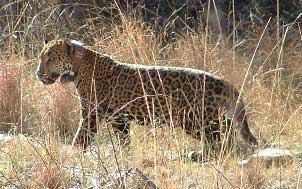Rare Arizona Jaguar Euthanized

A rare jaguar captured and collared in Arizona two weeks ago was euthanized after falling ill, state game officials said.
The jaguar was the only one spotted in the United States in more than a decade. Officials captured the cat Feb. 18 as part of a program to study bears and mountain lions. A procedure had previously been put in place to attach a satellite collar to any such fortuitously captured jaguar, so wildlife experts could monitor its movements to learn more about the extremely rare creatures.
The jaguar stopped moving, however.
Biologists found the male jaguar, brought it to a zoo, and he was put down that day. Officials say the cat, named Macho B, suffered kidney failure, common among old cats.
Macho B was first spotted by automatic trail cameras in 1996 when he was about age 2 or 3. He was thought to be 15 or 16 — relatively old for jaguars — when he was euthanized.
"This is an unfortunate and disappointing situation," said Gary Hovatter, deputy director of the Arizona Game and Fish Department. "We were looking forward to using the data acquired from Macho B to learn more about the species use of the borderland habitats in order to further conserve the species as a whole."
Sad course of action
Sign up for the Live Science daily newsletter now
Get the world’s most fascinating discoveries delivered straight to your inbox.
The cat had dropped from 118 pounds at the time of his capture last month to just 99.5 pounds Monday.
The decision to euthanize was made in consultations between the Arizona Game and Fish Department, the U.S. Fish and Wildlife Service and the Phoenix Zoo, according to the statement.
"It is a sad, but appropriate course of action to euthanize this animal given the hopelessly terminal nature of his condition," said Steve Spangle, U.S. Fish and Wildlife Service's Arizona field supervisor.
A necropsy (animal autopsy) will be performed to learn more about the jaguar's condition and to possibly provide clues to how long the animal had been sick.
In a statement released yesterday, officials did not say whether anything they might or might not have contributed the animal's demise. But they did say: "The jaguar's capture was guided by protocols developed in case a jaguar was inadvertently captured in the course of other wildlife management activities. The plan, which was created in consultation with leading jaguar experts, includes a protocol for capture, sedation and handling."
Big cats
Jaguars (Panthera onca) are the biggest cats in the Western Hemisphere. They once ranged from southern South America to the southern United States. By the late 1900s, none were thought to exist north of Mexico, but two independent sightings in 1996 confirmed jaguars still reached as far north as Arizona and New Mexico.
Remote cameras have also photographed jaguars in the Amazon and in central Mexico, where they're also rare.
Jaguars have been protected outside of the United States under the Endangered Species Act since 1973. That protection was extended to jaguars in the United States in 1997, the year after their presence here was confirmed.
- Video - How Cats Walk and Stalk
- Gallery: Endangered and Threatened Wildlife
- Cat News, Information and Images
Robert is an independent health and science journalist and writer based in Phoenix, Arizona. He is a former editor-in-chief of Live Science with over 20 years of experience as a reporter and editor. He has worked on websites such as Space.com and Tom's Guide, and is a contributor on Medium, covering how we age and how to optimize the mind and body through time. He has a journalism degree from Humboldt State University in California.










